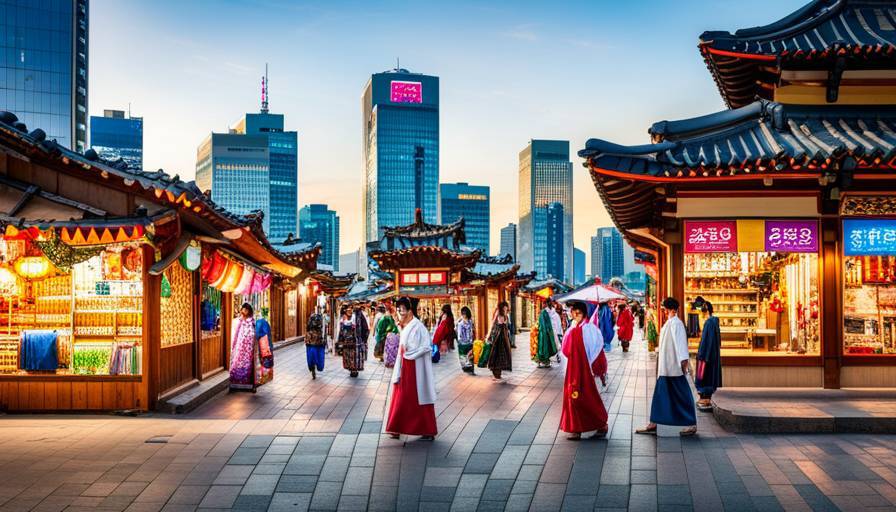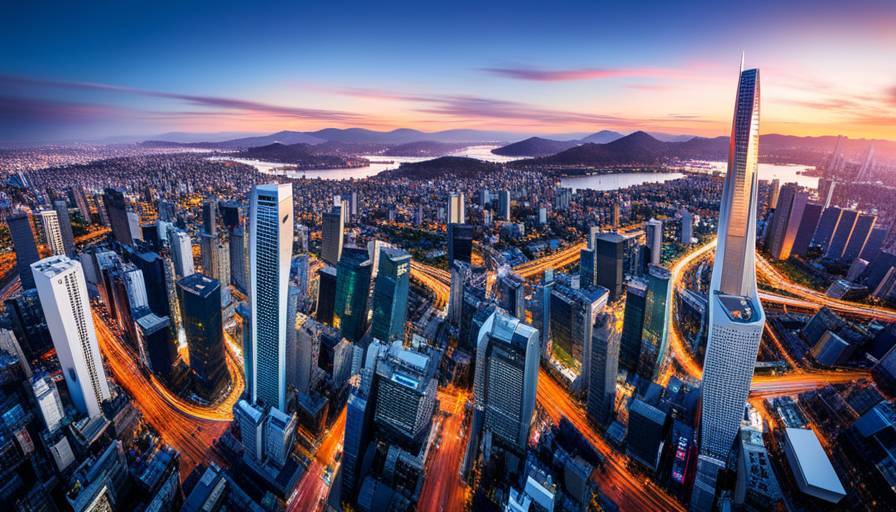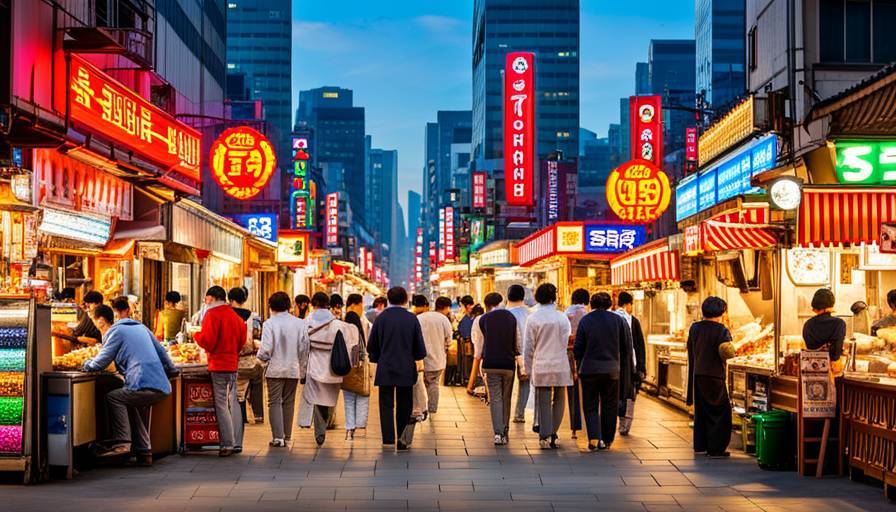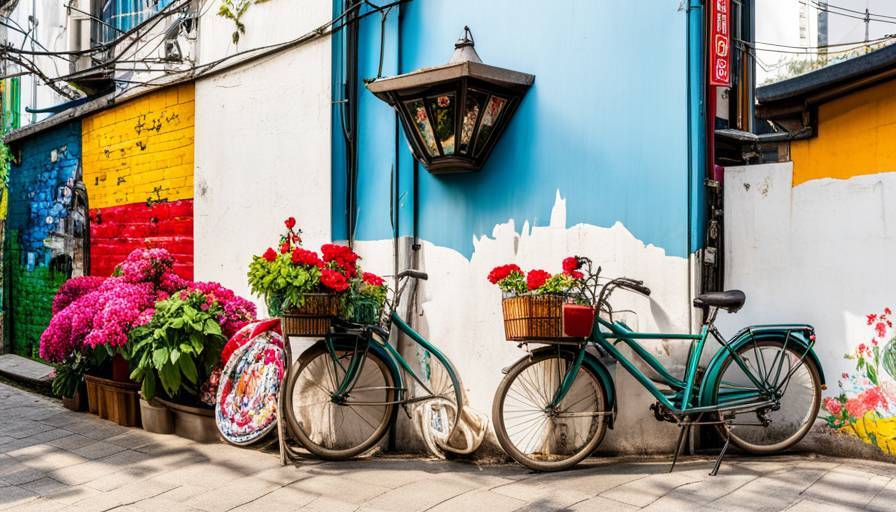Are you ready to get lost in the exhilarating fusion of ancient traditions, captivating landscapes, mouth-watering food, and ultra-modern skyscrapers that is Seoul? South Korea’s dynamic capital boasts an array of experiences for every kind of traveler. From the bustling night markets and vibrant street art scenes to the serene Buddhist temples and massive shopping districts, our comprehensive guide will unravel the mystery of Seoul — a city where palaces stand next to 21st-century architecture. Journey with us as we delve into cobblestone streets teeming with history, aerial views from towering cityscapes, and a rich gastronomic adventure peppered with spicy kimchi and irresistibly sweet Korean barbecue.
Seoul is a city with a rich history and culture, as well as modern attractions. Some must-visit places for tourists include Gyeongbokgung Palace, Bukhansan National Park, Namsan Tower, Myeongdong shopping district, Namdaemun market, Jongmyo Shrine, Banpo Bridge, and Cheonggyecheon Stream. Other popular spots include COEX Mall and Gangnam neighbourhood.
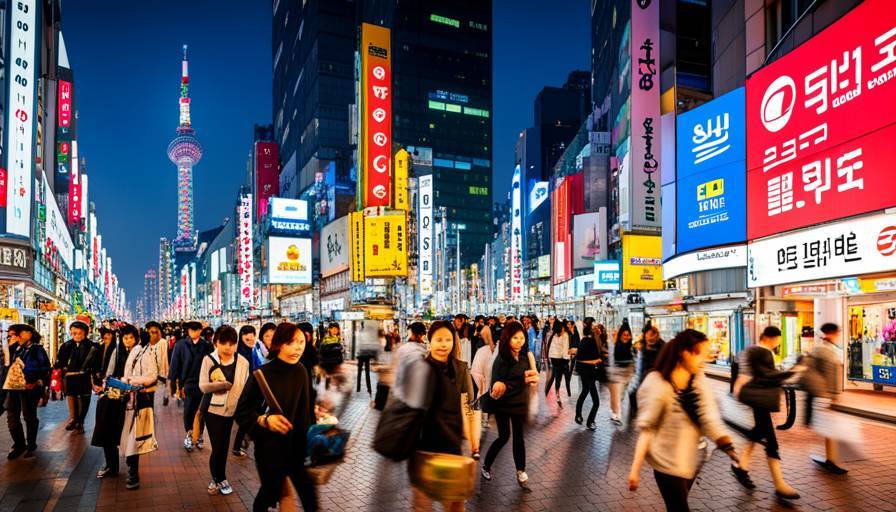
Unveiling Gyeongbokgung Palace
Nestled in the heart of Seoul, Gyeongbokgung Palace stands as a magnificent testament to Korea’s rich history and culture. As you step through the grand gates, prepare to be transported back to the Joseon Dynasty, where emperors once ruled and royal rituals were performed. The palace, which translates to “Palace of Shining Happiness,” was originally constructed in 1395 by King Taejo and served as the main residence for kings throughout various dynasties.
Imagine yourself walking through the palace grounds, soaking in the atmosphere that exudes regality and grandeur. The rhythmic sounds of traditional Korean music fill the air as you explore the meticulously restored buildings, each intricately adorned with intricate details and vibrant colors.
The highlight of Gyeongbokgung Palace is undeniably its main gate, Gwanghwamun. Towering majestically before you, this iconic structure has witnessed centuries of history unfold. Capture the perfect photo against its impressive backdrop as you discover the stories that lie within.
As you venture deeper into the palace complex, make sure not to miss Geunjeongjeon Hall, where important state affairs took place. Its expansive wooden terrace offers a glimpse into a time when officials gathered and elaborate ceremonies were held. Stand at its center and marvel at the elaborate ceiling adorned with beautiful artwork known as dancheong.
Another must-see within Gyeongbokgung Palace is the National Folk Museum of Korea, located on its grounds. Here, you can delve deeper into Korean folklore, traditions, and daily life through a vast collection of artifacts and exhibits. Gain insight into ancient agricultural practices or admire traditional clothing styles worn by different classes of society.
To truly immerse yourself in history, visit Gyeonghoeru Pavilion, a stunning structure set atop an artificial lake. Originally used for royal banquets and receptions, this picturesque pavilion offers a tranquil escape from the bustling city. Picture yourself sitting by the water’s edge, taking in the reflection of the pavilion against the clear blue sky.
Now, some may argue that Gyeongbokgung Palace is merely a tourist attraction, crowded with visitors and lacking authenticity. However, I would counter that by saying that while it is undeniably popular among tourists, the palace still retains its cultural significance and provides a unique glimpse into Korea’s storied past.
As I wandered through its expansive courtyards and marveled at the detailed craftsmanship of each building, I felt a deep sense of connection to the country’s heritage. The echoes of history resonated within me as I imagined emperors walking these very grounds centuries ago.
Moving beyond Gyeongbokgung Palace, let’s explore the key heritage sites that surround this majestic landmark.
Key Heritage Sites Around Palace
As you venture beyond Gyeongbokgung Palace, you’ll discover a treasure trove of key heritage sites that further enrich your understanding of Korea’s history. These sites provide insights into different aspects of Korean culture and offer a chance to explore various architectural styles.
Jogyesa Temple, located just east of the palace, stands as one of the most significant Buddhist temples in Seoul. Awash in vibrant colors and adorned with intricate details, this temple offers a peaceful sanctuary amidst the bustling city. Witness monks engaged in their daily rituals or participate in meditation sessions to experience the tranquility within.
Just a short walk from Jogyesa Temple lies Changdeokgung Palace, known for its biwon or secret garden. Step into this serene oasis concealed within the palace walls and stroll along winding paths that lead to hidden pavilions and picturesque ponds. The harmony between man-made structures and the natural landscape creates an enchanting ambiance that captivates visitors.
For a taste of traditional Korean village life, make your way to Bukchon Hanok Village. Nestled on a hillside, this charming neighborhood is filled with well-preserved hanok (traditional Korean houses) that date back to the Joseon Dynasty. Lose yourself amidst narrow alleyways and admire the timeless beauty of hanbok-clad locals going about their daily lives.
On my visit to Bukchon Hanok Village, I had the opportunity to participate in a traditional tea ceremony at one of the many tea houses scattered throughout the area. Sitting cross-legged on plush cushions, sipping aromatic green tea, I felt transported back in time as I absorbed the ambience and appreciated the meticulous craftsmanship of the hanok architecture.
Now that we’ve explored Gyeongbokgung Palace and its neighboring heritage sites, let’s turn our attention to some of the most breathtaking viewpoints in Seoul.
- Bukhansan National Park, one of the leading attractions in Seoul, recorded a footfall of nearly 5 million visitors annually as of 2020.
- As per a survey by Korea Tourism Organization in 2020, approximately 70% of foreign tourists visited Gyeongbokgung Palace during their trip to Seoul.
- The N Seoul Tower, with its mesmerizing city views, attracts over 8.4 million domestic and international visitors annually as stated by the Seoul Metropolitan Government in a 2019 survey.
Spectacular Viewpoints
When visiting Seoul, one cannot miss the opportunity to experience the city from its breathtaking viewpoints. These locations not only offer panoramic views of the bustling metropolis but also provide a unique perspective on the city’s diverse landscape and architecture.
One such viewpoint is N Seoul Tower, perched atop Namsan Mountain. Ascending to the top of the tower is an experience in itself as you ride a cable car or hike through beautiful trails surrounded by nature. Once at the summit, be prepared to be mesmerized by stunning 360-degree views of Seoul. The digital observatory allows visitors to learn about the landmarks they see while taking in the breathtaking scenery. For a memorable dining experience, indulge in a meal at the revolving restaurant located within the tower.
Another must-visit viewpoint is Banpo Bridge, known for being home to the world’s longest “bridge fountain.” When evening falls, this bridge transforms into a dazzling spectacle as thousands of colorful lights illuminate streams of water shooting up into magnificent displays. As you stand on the bridge or along the riverside promenade, you can enjoy this captivating water show while admiring picturesque views of the Han River and surrounding skyscrapers.
One visitor to Banpo Bridge describes their experience: “As twilight approached, I found myself standing on Banpo Bridge, entranced by the vibrant colors dancing in harmony with cascading water. It was a magical moment that encapsulated both the beauty of nature and modern engineering. The view from this bridge reminded me that Seoul is a city where tradition and innovation seamlessly coexist.”
For those seeking a more natural viewpoint, Bukhansan National Park offers a serene escape from urban life while providing an incredible vista of Seoul’s skyline. This expansive park features numerous hiking trails that cater to various skill levels, allowing visitors to immerse themselves in nature and enjoy stunning views throughout their journey. From elevated peaks like Baekundae or Bibongsan, one can witness the city unfold beneath them, framed by lush mountains and greenery. It’s a perfect spot to reflect on the contrast between Seoul’s urban development and the natural splendor of its surroundings.
After marveling at these breathtaking viewpoints, let’s now explore how you can immerse yourself in Korean culture during your visit to Seoul.
- When visiting Seoul, make sure to experience the city from its stunning viewpoints such as N Seoul Tower, Banpo Bridge, and Bukhansan National Park. These locations offer panoramic views of the city and its diverse landscape and architecture. N Seoul Tower provides a memorable dining experience at the revolving restaurant and an opportunity to learn about the landmarks visible from the digital observatory. Banpo Bridge’s world’s longest “bridge fountain” transforms into a captivating water show at night, offering picturesque views of the Han River and surrounding skyscrapers. Bukhansan National Park offers numerous hiking trails with varying difficulty levels that provide incredible vistas of Seoul’s skyline framed by lush mountains and greenery. Experiencing these breathtaking viewpoints is a great way to witness the contrast between Seoul’s urban development and natural beauty while also exploring Korean culture during your visit.
Immersion in Korean Culture
Seoul is a city that effortlessly blends modernity with its rich cultural heritage. To truly appreciate and immerse yourself in Korean culture, you can delve into various experiences and attractions that showcase the country’s traditions, history, and artistic expressions.
A visit to Gyeongbokgung Palace is an absolute must. As the largest and most important palace in Seoul, it serves as a symbolic icon of Korea. Walking through its grand gates, past intricately designed buildings and serene courtyards, you’ll feel transported to a time when ancient dynasties ruled. Don’t miss the opportunity to witness the Changing of the Guard ceremony, adding another layer of authenticity to your cultural exploration. Adjacent to the palace is the National Folk Museum of Korea, which provides fascinating insights into traditional Korean life through exhibitions and artifacts.
Imagine standing amidst the vast courtyard of Gyeongbokgung Palace with sunlight filtering through the elaborate rooftops, catching glimpses of visitors dressed in vibrant hanboks (traditional Korean attire). You take a moment to absorb the tranquility and heritage that surrounds you, appreciating how this experience bridges the gap between past and present.
While exploring Seoul’s cultural gems, make sure to wander through Bukchon Hanok Village. This hillside neighborhood preserves traditional Korean houses known as hanoks. Strolling along its narrow alleyways lined with these charming wooden structures evokes a sense of nostalgia and connection to Korea’s past. Immerse yourself in the rich heritage as you observe residents going about their daily lives and discover quaint cafes, art galleries, and shops that showcase traditional crafts. It’s a place where traditional aesthetics and modern sensibilities harmoniously coexist.
Jogyesa Temple offers another opportunity to delve into Korean Buddhism and its profound influence on the nation’s culture. Adorned with colorful lanterns, this vibrant temple stands out amidst the surrounding urban landscape. Participating in Buddhist ceremonies or visiting during festivals such as Buddha’s birthday allows you to witness the spiritual devotion and rituals of local practitioners.
As we have explored some of the best viewpoints in Seoul and ways to immerse ourselves in Korean culture, let us now turn our attention to another aspect of this dynamic city: experiencing the charm of a traditional Hanok village.
Traditional Hanok Village
Tucked away in the bustling heart of Seoul lies a hidden gem that transports visitors back in time: the Traditional Hanok Village. This charming neighborhood showcases the beauty and elegance of traditional Korean architecture with its well-preserved hanoks, or traditional Korean houses. As you explore the narrow alleyways of Bukchon Hanok Village, you’ll be captivated by the sight of these beautifully crafted homes, adorned with decorative rooftops, intricately carved wooden panels, and stone courtyards.
Imagine taking a leisurely stroll through this picturesque village, feeling the smooth cobblestones beneath your feet and marveling at the exquisite details of the hanoks. You might stumble upon small art galleries, cozy teahouses, or quaint boutiques nestled within these historical houses. The village offers a unique blend of old and new, with residents gracefully blending traditional customs and modern lifestyles.
One of the highlights of visiting Bukchon Hanok Village is the opportunity to experience hanbok, traditional Korean attire. Many shops allow visitors to rent these beautiful garments, allowing you to fully immerse yourself in the rich cultural heritage of Korea as you wander through the village streets dressed in vibrant colors and flowing fabrics.
After exploring the charming Traditional Hanok Village, let’s move on to another must-visit attraction that provides insight into Korea’s spiritual traditions.
Visit Jogyesa Temple
Nestled amidst the urban chaos and tall skyscrapers of Seoul stands Jogyesa Temple, a place of tranquility and spiritual significance. As one of Korea’s most important Buddhist temples, Jogyesa serves as the head temple of the Jogye Order, representing Zen Buddhism in Korea.
Stepping through its grand entrance gate sets a serene atmosphere that instantly washes away any worries or stress. The air is filled with whispers of prayer, the scent of incense, and the rhythm of wooden percussion instruments echoing in the distance. The temple exudes a sense of timeless wisdom and peace, making it a perfect retreat from the bustling city.
As you explore the temple grounds, you’ll encounter various halls and structures that hold religious importance. The Daeungjeon Hall is the main hall of Jogyesa Temple, housing several Buddha statues and serving as a place for ceremonies and meditation. The Beopbojeon Hall stands out with its intricate decorations and serves as a repository for Buddhist scriptures.
To truly immerse yourself in the traditional rituals of Jogyesa, consider visiting during one of the temple’s major events or festivals. During Buddha’s birthday celebration, which takes place in May, the temple grounds are adorned with colorful lanterns, creating a mesmerizing spectacle that draws visitors from all over. Witnessing the vibrant festivities and joining in on traditional practices offers a unique insight into Korean Buddhism.
From exploring the spiritual haven of Jogyesa Temple to indulging in retail therapy at Myeongdong, our journey through Seoul continues.
Shopping Extravaganza in Myeongdong
When it comes to shopping in Seoul, few places can rival the vibrant and trendy atmosphere of Myeongdong. Located in the heart of the city, this bustling shopping district is a haven for shopaholics seeking the latest fashion trends, skincare products, accessories, and more. As you walk down the lively streets of Myeongdong, you’ll be captivated by the dazzling array of stores and boutiques that line the area.
From renowned international brands like H&M, Zara, and Top Ten to popular Korean clothing stores such as SPAO, Myeongdong offers a wide range of options to suit every style and budget. In addition to clothing, skincare aficionados will be delighted by the presence of famous beauty brands like Innisfree, Nature Republic, Missha, and Olive Young. These shops offer an extensive selection of cosmetics and skincare products that cater to different skin types and preferences.
But shopping in Myeongdong doesn’t stop at clothing and cosmetics. The district also boasts an impressive collection of shoe stores where you can find stylish footwear from brands like Nike, Converse, JD Sports, and ABC Mart. Furthermore, if you’re on the lookout for accessories such as jewelry pieces or bags to complete your ensemble, there are plenty of shops in Myeongdong that cater to those needs.
The shopping experience in Myeongdong extends beyond its vibrant streets. Visitors can explore the underground shopping center below ground level, providing even more choices for shopaholics. Additionally, nearby shopping malls like Lotte Young Plaza and Lotte Department Store offer a mix of high-end and affordable stores for an enhanced shopping experience.
As you dive into this shopping extravaganza in Myeongdong, don’t forget to take breaks and refuel with some delectable street food options available throughout the area.
Street Food at Namdaemun Market
No visit to Seoul would be complete without indulging in the sumptuous street food offerings, and one of the best places to experience this culinary delight is at Namdaemun Market. Located near Myeongdong, this bustling traditional market is a haven for food enthusiasts with its diverse array of street food stalls.
As you make your way through the labyrinthine alleys of Namdaemun Market, your senses will be immediately enticed by the sights and aromas wafting from the food stalls. From grilled lobsters and tornado potatoes to roasted sweet potatoes and fried chicken, there’s something for everyone’s taste buds.
One popular street food delicacy that shouldn’t be missed is the mouth-watering Wangbijib BBQ restaurant where you can savor delicious Korean barbeque dishes made with high-quality cuts of meat. Another must-try is the tonkatsu (breaded and deep-fried pork cutlet) at Myeongdong Donkaseu, known for its crispy exterior and tender meat inside.
In addition to these savory delights, Namdaemun Market also offers a variety of seafood options such as abalone, scallops, crabs, and more. And if you’re craving something refreshing to quench your thirst, treat yourself to some pomegranate juice or cool down with a delightful ice cream cone.
Picture yourself immersed in the vibrant atmosphere of Namdaemun Market as you stroll through the lively lanes, sampling bites of various street food. As you take a bite into a piping hot piece of fried chicken coated in a crispy golden crust, you’ll be met with an explosion of flavors. The combination of savory spices tantalizes your taste buds as the tender meat melts in your mouth. It’s an experience that captures the essence of Korean street food culture and leaves a lasting impression on your culinary journey.
As you explore the historical wonders of Seoul, be sure to carve out time to visit the fascinating Seoul Museum of History.
Historical Journey through Seoul Museum of History
Immerse yourself in the rich history and cultural heritage of Seoul with a visit to the Seoul Museum of History. This museum serves as a gateway to the city’s past, offering visitors a chance to embark on a captivating historical journey. Located in the heart of Seoul, near Gyeonghuigung Palace, the museum showcases various exhibitions and artifacts that highlight the city’s evolution from its ancient beginnings to the modern metropolis it is today.
Step inside and be transported back in time as you explore the meticulously curated displays that depict the different eras of Seoul’s history. From remnants of the ancient Joseon Dynasty to exhibits showcasing the influence of Japanese colonial rule, each section offers a glimpse into significant milestones and events that have shaped this vibrant city.
Learn about the establishment and growth of Seoul as a capital city, witnessing how it transformed into a hub of Korean culture, politics, and commerce over time. Walk through life-size recreations of traditional village scenes and gain insight into everyday life during different periods. Marvel at the intricate details of royal palaces like Gyeongbokgung and Changdeokgung, which played prominent roles in shaping Korea’s history.
The Seoul Museum of History goes beyond traditional exhibitions and utilizes interactive displays and multimedia presentations to enhance your learning experience. Engage with touchscreens, audio guides, and virtual reality technology that bring history to life before your eyes. Witness historic moments through visual storytelling and immersive exhibits, fostering a deeper understanding and appreciation for Seoul’s rich heritage.
Tribute at War Memorial of Korea
Pay your respects to those who sacrificed their lives for their country at the War Memorial of Korea. Situated in Yongsan-gu, this solemn memorial serves as a place for reflection and remembrance, honoring the Korean War veterans and preserving the memory of those affected by the conflict.
As you step onto the grounds of the memorial, you’ll immediately be struck by the grandeur of the site. A massive outdoor exhibition area showcases military equipment, including tanks, helicopters, and fighter jets, allowing visitors to observe the machinery used during significant wartime events. It provides a tangible reminder of the scale and intensity of the Korean War.
Enter the main building and find yourself surrounded by powerful exhibits that chronicle the history of the war. Explore galleries filled with photographs, artifacts, and personal accounts that vividly portray both the heroism and tragedy experienced by soldiers and civilians alike. The museum’s well-curated collection provides a comprehensive understanding of not just the Korean War but also its impact on South Korea’s development.
One of the highlights of your visit is undoubtedly the outdoor Memorial Hall, dedicated to honoring those who lost their lives defending their country. Rows upon rows of white marble slabs bear the names of fallen soldiers, creating a somber yet awe-inspiring sight. Take a moment to reflect on their sacrifice and pay your own tribute at this solemn space.
Just as visiting a graveyard can elicit feelings of respect and contemplation for loved ones passed, walking through this memorial stirs emotions and gratitude for those who fought bravely for their homeland.
When you leave the War Memorial of Korea, you’ll carry with you a deeper appreciation for not only Seoul’s role in recent history but also for the courage and resilience displayed by those who fought to protect it.
Discover Seoul’s Vibrant Nightlife
Seoul is renowned for its vibrant and electrifying nightlife, offering a plethora of entertainment options that cater to various tastes and preferences. Whether you’re a fan of live music, dance clubs, or cozy bars, Seoul has it all. The city comes alive after dark, pulsating with energy and enthusiasm. So, if you’re looking to experience the best of Seoul’s nightlife scene, here are some of the must-visit places and activities.
One of the most popular areas for nightlife in Seoul is Gangnam. This upscale district boasts an array of trendy clubs, hip lounges, and stylish bars that attract both locals and tourists alike. It’s home to some of the city’s most prestigious nightclubs, such as Club M2 Seoul, Aura Seoul, Club Madholic Seoul, and Club Octagon Seoul.
Club M2 Seoul is highly recommended if you’re seeking a high-end bar experience complete with impressive performances and a VIP section. On the other hand, Aura Seoul is known as one of the best electric nightclubs in the city with its lively atmosphere and top-notch DJs. Meanwhile, if you’re looking for good music, friendly staff, and a great atmosphere overall at reasonable prices, Club Madholic is worth checking out. And let’s not forget about Club Octagon, a massive warehouse-sized space in Gangnam famous for hosting big names in K-Pop.
Apart from Gangnam, other districts like Hongdae also offer a vibrant clubbing scene with numerous bars and live music venues. With hundreds of clubs and bars spread across these areas, there’s something for everyone’s taste. However, it’s important to note that Korean clubs usually enforce standard dress rules; ladies should avoid open-toed shoes while gents should avoid shorts.
While clubs may be the highlight of Seoul’s nightlife experience for many visitors, there are other options available as well. You can explore the city’s underground music scene by visiting indie venues and live performance spaces, where you can witness talented local bands and musicians showcasing their talents.
Furthermore, Seoul transforms its shopping districts into cultural spaces after dark. These districts, such as Myeongdong and Dongdaemun, often host fashion shows, dance performances, and live concerts year-round. So even if clubbing isn’t your thing, you can still immerse yourself in the vibrant nightlife atmosphere of Seoul through these alternative options.
Now that we’ve explored the vibrant nightlife in Seoul, let’s shift our focus to one specific district known for its dining and parties: Gangnam.
Dining and Parties in Gangnam
When it comes to dining and parties in Seoul, Gangnam is undoubtedly a neighborhood that stands out. Known for its sleek and modern ambiance, this district offers an impressive array of restaurants, cafes, bars, and clubs where you can indulge in delectable cuisine and enjoy a night of revelry.
Gangnam boasts a diverse culinary scene that caters to all tastes. From traditional Korean cuisine to international flavors, you can find it all here. For those seeking an authentic Korean dining experience, there are numerous barbecue restaurants where you can savor grilled meats like galbi (marinated beef short ribs) or samgyeopsal (pork belly) while enjoying Soju (Korean distilled alcohol) with friends.
But Gangnam is not just about traditional cuisine; it also offers a variety of international dining options. You can find upscale fine-dining establishments serving fusion cuisine or trendy cafes specializing in artisanal coffee and Instagram-worthy desserts.
After enjoying a satisfying meal, the night is far from over in Gangnam. The district comes alive with its vibrant party scene as numerous bars and clubs open their doors to eager party-goers. Whether you prefer intimate lounges with expertly crafted cocktails or energetic clubs with live DJs, Gangnam has options to suit every taste and mood.
For a classy and sophisticated atmosphere, head to one of the rooftop bars that offer stunning views of the city skyline. These venues provide a perfect backdrop for socializing and enjoying a drink with friends or colleagues.
Meanwhile, if you’re looking for an unforgettable clubbing experience in Gangnam, Club Octagon is definitely worth a visit. With its spacious layout and state-of-the-art sound system, this club draws in both local party enthusiasts and international DJs. Prepare to dance the night away amidst an electrifying atmosphere!
Seoul’s vibrant nightlife scene goes beyond just Gangnam; it extends to other districts offering unique experiences. But before you embark on your adventure, there are some essential tips you should keep in mind.
Essential Tips for Visiting Seoul
Seoul, the vibrant capital city of South Korea, is a destination that offers a perfect blend of tradition and modernity. To make the most of your visit and navigate this bustling city like a local, here are some essential tips to keep in mind.
1. Plan your itinerary wisely: With countless attractions to explore in Seoul, it’s important to plan your days accordingly. Research the must-visit sites, such as Bukhansan National Park, Gyeongbokgung Palace, and Myeongdong shopping district, and allocate enough time for each location. Consider the opening and closing hours of palaces and museums, as they usually close around 6pm. Also, be aware that some attractions are closed on specific days of the week – for example, palaces are closed on Tuesdays.
2. Get a T-Money card: The T-Money card is a reloadable transportation card that can be used on buses, subways, taxis, and even at selected convenience stores. It offers convenience and helps save money compared to purchasing individual tickets for every trip. You can easily obtain a T-Money card at the airport or any convenience store by simply loading it with cash.
3. Embrace public transportation: Seoul has an extensive and efficient public transportation system comprised of subways, buses, and taxis. The subway is particularly reliable and well-connected to major attractions. During peak hours, the subway can get crowded, so if you prefer a more spacious option, consider taking buses which are also frequent and convenient.
Imagine yourself immersed among locals on a busy subway platform in Seoul – taking in the sights and sounds while effortlessly traveling to your desired destinations.
4. Engage with local cuisine: One cannot truly experience Seoul without indulging in its delightful cuisine. Be adventurous and try traditional dishes such as bibimbap, bulgogi, and kimchi. Explore street food markets like Namdaemun Market or Gwangjang Market for a vast array of affordable and tasty snacks. And don’t forget to visit themed eating places or Hanok-styled cafes for unique Korean cuisine and drinks.
5. Practice respectful behavior: As a visitor, it’s important to be mindful of local customs and cultural norms. Keep noise levels low on public transport and maintain cleanliness by disposing of trash in convenience store bins since there are few street bins available. Dress modestly and considerate of Korean societal norms to avoid unwarranted staring. Also, be cautious of suspicious signs or pictures that could lead you astray.
6. Be prepared with translation tools: While many Koreans can speak basic English, it’s always helpful to have translation apps readily available. These tools can assist you in cases where language barriers might pose challenges when communicating with locals or reading menus.
By following these essential tips, your visit to Seoul will be smoother, more enjoyable, and highly memorable. Now let’s dive into the must-visit attractions in Seoul that should be on your itinerary.
